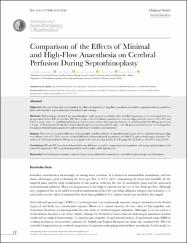Comparison of the effects of minimal and high-flow anaesthesia on cerebral perfusion during septorhinoplasty
Citation
Kazancıoğlu, L., Batıcık, L., Erdivanlı, B., Sen, A., Dursun, E. (2019). Comparison of the effects of minimal and high-flow anaesthesia on cerebral perfusion during septorhinoplasty. Turkish Journal of Anaesthesiology and Reanimation, 47(1), 12-16.Abstract
Objective: The aim of this study was to analyse the effects of minimal-and high-flow anaesthesia on cerebral oxygenation during septorhinoplasty with controlled hypotension using near-infrared spectroscopy. Methods: Eighty patients scheduled for septorhinoplasty under general anaesthesia with controlled hypotension were randomised into two groups: minimal-flow (MF) or high-flow (HF). Both groups received desflurane anaesthesia to maintain bispectral index values at 40%-50% and 0.25-0.5 µg kg?1 min?1 i.v. remifentanyl infusion to maintain mean arterial blood pressure between 55 and 65 mmHg. The MF group received 5 L min?1 of fresh gas flow for the first 10 mins then the gas flow was reduced 0.4 L min?1. The HF group received 2 L min?1 of fresh gas flow throughout. Haemodynamic parameters and cerebral oxygen saturation were measured. Results: There were no statistical differences in demographic variables, duration of anaesthesia and surgery, time to extubation and proceeding to an Aldrete score of 9. There were no statistical differences in haemodynamic parameters, end-tidal CO2 and cerebral oxygen saturation. The amount of desflurane used in the MF group was significantly lower than that used in the HF group (30.5±9.8 mL vs. 48.5±12.1 mL; p<0.05). Conclusion: MF and HF anaesthesia did not lead to any difference in cerebral oxygen saturation in patients undergoing septorhinoplasty with controlled hypotension. MF anaesthesia may thus be used as safely as HF anaesthesia is.
Source
Turkish Journal of Anaesthesiology and ReanimationVolume
47Issue
1URI
https://doi.org/10.5152/TJAR.2018.3678https://app.trdizin.gov.tr/makale/TXpNM056QXhNUT09
https://hdl.handle.net/11436/5754


















